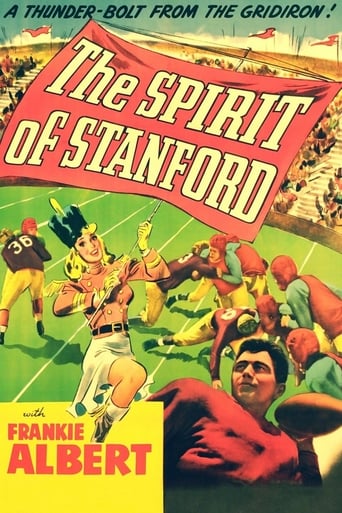john_meyer
The movie is lame, and the acting is strictly amateur. However, the stock footage of Stanford is wonderful, and the actual game footage is excellent, and for fans of old football, priceless.There are some interesting musical numbers which are actually not that bad, in their own way. It is also amusing to briefly see Lloyd Bridges in one of his first screen appearances. He has bit parts in at least two scenes. He had a long career, and fathered two well-known actors, Jeff & Beau.If I were reviewing the movie as an entertainment vehicle, I'd give it a three-star rating, but because of the Stanford shots and actual football scenes, I rate it higher.BTW, the "Stanford Stadium" shots are actually the Rose Bowl, I think.
Floyd Bekins
Frank Albert, Stanford's All American quarterback, the main character in the movie "The Spirit of Stanford", was played by himself, and he was credited as such when the film was shown in theaters.The Stanford football team had lost nearly all of its games in the fall of 1939, when Albert was a sophomore. Sports writers predicted even worse results for 1940 when Stanford hired the coach of the team of the University of Chicago, which had not only lost all of its games in 1939, but had even cancelled its football program permanently.The new coach was Clark Shaughnessy, who, while in Chicago, had worked as a consultant to the Chicago Bears in developing a new style of offense: the T-Formation.In all previous systems, the center had to put both of his hands on the ball and start the play while looking upside down through his legs and passing the ball back to one of the four players in the backfield. But in the new "T", which became the basis of all modern football, as players and fans have seen the game since then, the play starts with the center facing straight ahead as an effective offensive blocking lineman, and using only one hand to lift the football back through his legs into the waiting hands of the quarterback, who turns and hands it (or passes it back or laterally) to one of the running backs, or keeps it and runs with it, or passes it forward to a receiver.The sports writers were unimpressed by this combination of losers and their "Model-T" machine, kept under wraps in secret practice sessions. They predicted, each week of that season, that Stanford would lose the following Saturday's game.When the team proved them wrong by beating every opponent on their schedule that fall, the "experts" still predicted they would lose the Rose Bowl Game against Nebraska, especially when the Cornhuskers coach took his team the day before the New Year's day classic to watch the T-Formation executed by the visiting Chicago Bears, winning against the local Los Angeles Bulldogs. They were wrong again. Watching it from stadium bleachers is not the same as facing it on the gridiron.The new Stanford team, which the writers had christened "The Wow Boys", had going for it the advantage of surprise, with the newness of the "T". But their real "edge" was something else -- that which football coaches try to instill in today's teams: a positive attitude spurred by heightened emotion. That new element, which those former losers had gained, and which inspired this movie's title, was "The Spirit of Stanford".After graduation and Navy service in World War II, Albert continued his football career as the original quarterback of the newly-formed San Francisco Forty-Niners, and later, as its coach.


